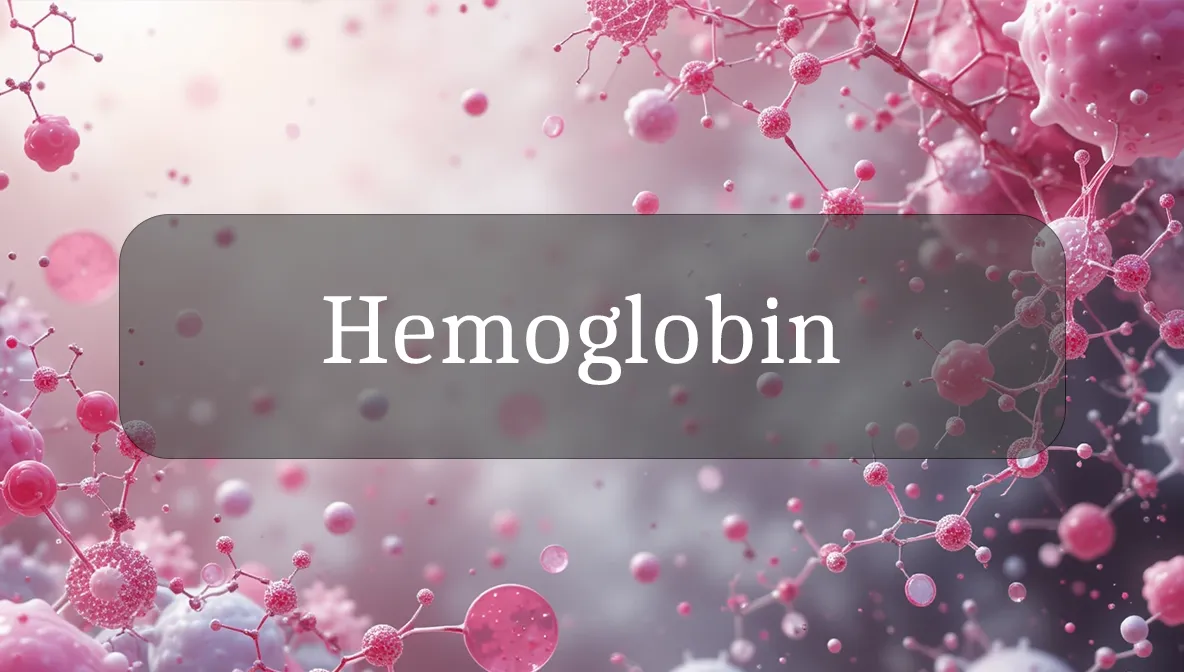Protein That Fuels Your Body with Oxygen
Hemoglobin is like your body’s oxygen delivery service, a protein that carries oxygen from your lungs to every cell in your body while also transporting carbon dioxide back out. It’s a vital player in your daily wellness, keeping you energized and alert. Let’s explore what hemoglobin is, how it benefits your health, and practical ways to support it—all in a clear, friendly way to empower your health choices.
Identity and Type
Hemoglobin is a structural protein and an essential protein, meaning your body produces it from amino acids and other nutrients in your diet, not something you consume directly. It’s found in red blood cells and made up of four protein chains (two alpha and two beta globins) bound to a heme group, which contains iron. This iron gives hemoglobin its red color and ability to bind oxygen. It’s rich in amino acids like histidine, leucine, and glycine, and its unique structure makes it a key oxygen carrier.
Biological Role and Health Benefits
Hemoglobin is your body’s oxygen lifeline, powering every cell and system. Here’s how it supports your wellness:
- Oxygen Delivery: Hemoglobin picks up oxygen in the lungs and delivers it to tissues, fueling energy production.
- Carbon Dioxide Removal: It carries waste carbon dioxide from cells back to the lungs for exhalation.
- Energy and Vitality: By ensuring oxygen reaches muscles and organs, it keeps you alert, active, and energized.
- Brain Function: Oxygen delivery supports focus, memory, and cognitive health.
- pH Balance: Hemoglobin helps regulate blood acidity, maintaining a stable internal environment.
By keeping oxygen flowing, hemoglobin boosts your stamina, mental clarity, and overall vitality.
Dietary Sources and Supplements
Your body makes hemoglobin using amino acids, iron, and other nutrients from your diet. Top sources include:
- Lean Meats: Beef, chicken, turkey, and especially liver (rich in iron and amino acids).
- Fish and Seafood: Tuna, salmon, and oysters (high in iron and omega-3s).
- Eggs: A good source of amino acids and nutrients for hemoglobin production.
- Plant-Based Sources: Lentils, spinach, tofu, and fortified cereals (pair with vitamin C-rich foods to boost iron absorption).
- Nutrient Boosters: Iron (red meat, beans), vitamin C (oranges, bell peppers), vitamin B6 (bananas, chickpeas), folate (leafy greens, avocados), and vitamin B12 (dairy, fortified plant milk) support hemoglobin synthesis.
Iron supplements (8–18 mg daily, depending on age and sex) or protein powders (e.g., whey, 5–10 grams daily) may help if dietary intake is low. Aim for 0.8–1.2 grams of protein per kilogram of body weight daily (e.g., 56–84 grams for a 150-pound person).
Signs of Imbalance
Hemoglobin “imbalance” refers to low (anemia) or high levels, often due to nutrient deficiencies, health conditions, or lifestyle factors. Signs include:
- Low Hemoglobin (Anemia):
- Fatigue or weakness (low oxygen delivery).
- Pale skin or brittle nails.
- Shortness of breath or dizziness.
- Cold hands and feet.
- High Hemoglobin:
- Headaches or blurred vision (often due to dehydration or lung issues).
- Reddish skin or itching.
- Increased blood thickness, raising clot risk (rare).
These signs may stem from iron deficiency, vitamin B12/folate shortage, chronic diseases, or genetic conditions like sickle cell anemia.
Supporting Optimal Levels or Function
To keep hemoglobin healthy and maintain its benefits, try these practical steps:
- Eat Iron-Rich Foods: Include heme iron (meat, fish) and non-heme iron (beans, spinach) in meals, paired with vitamin C (e.g., orange juice) to boost absorption.
- Boost Key Nutrients: Eat folate-rich foods (leafy greens, lentils), vitamin B12 (eggs, dairy), and vitamin B6 (potatoes, tuna).
- Stay Hydrated: Drink 8–10 cups of water daily to support blood volume and oxygen transport.
- Exercise Moderately: Activities like brisk walking or cycling improve oxygen use and red blood cell production.
- Get Enough Sleep: Sleep (7–9 hours) supports red blood cell formation and overall health.
- Avoid Iron Blockers: Limit coffee, tea, or calcium-rich foods during iron-rich meals, as they can reduce iron absorption.
- Consider Supplements: Iron (if deficient, under medical guidance) or protein powders can support hemoglobin production.
Safety, Interactions, and Precautions
Hemoglobin is naturally produced and safe, but consider these points:
- Iron Overload: Too much iron (above 45 mg daily from supplements) can cause nausea, liver damage, or toxicity. Only supplement if prescribed.
- Chronic Conditions: Anemia from kidney disease, cancer, or autoimmune disorders requires medical management.
- Supplements: Iron or protein supplements are generally safe but may cause digestive upset (e.g., constipation from iron).
- Allergies: Supplements from fish or dairy may trigger allergies in sensitive individuals.
- Genetic Disorders: Conditions like sickle cell anemia or thalassemia affect hemoglobin and need specialized care.
- Medications: Some drugs (e.g., chemotherapy) may lower hemoglobin. Consult your doctor if on such treatments.
Fun Fact
Did you know hemoglobin’s iron is what makes your blood red? Each hemoglobin molecule can carry four oxygen molecules, like a tiny taxi service delivering life-giving oxygen to every corner of your body!
Citations
- National Institutes of Health. (2023). Iron and hemoglobin health. MedlinePlus.
- Mayo Clinic. (2024). Nutrition for anemia and blood health.
- Cleveland Clinic. (2022). The role of hemoglobin in oxygen transport.
- World Health Organization. (2020). Protein and amino acid requirements in human nutrition.
- USDA FoodData Central. (2023). Nutrient profiles for iron- and protein-rich foods.

